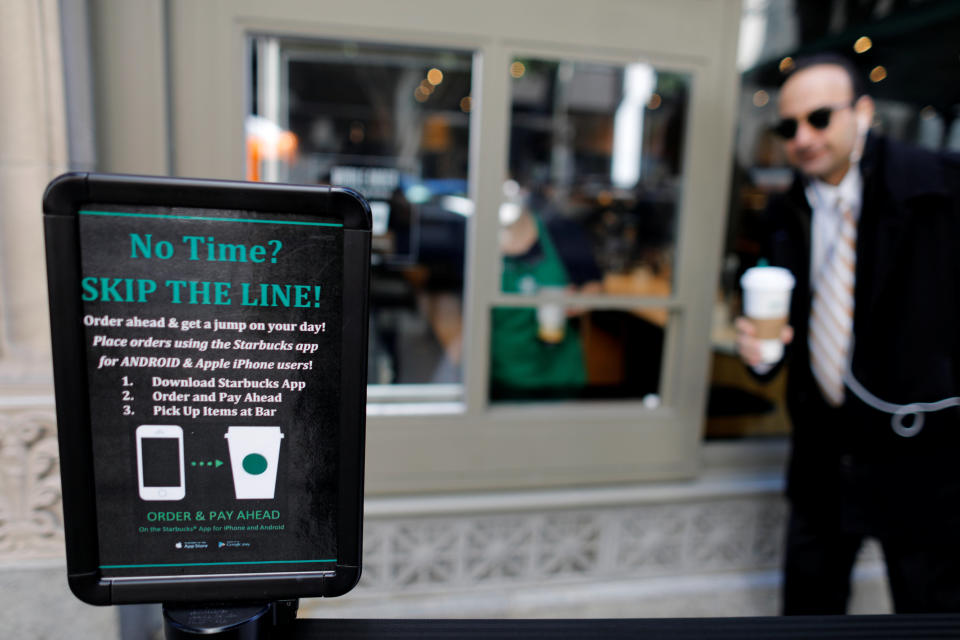Why Americans aren't using their phones to make payments in stores
Americans who travel to China will find one thing somewhat unusual: In restaurants, stores and markets, people will take out their phones instead of credit cards when they’re ready to pay.
Despite all the buzz and excitement, mobile payment in stores still hasn’t gained much steam in the U.S. Mobile transactions barely accounted for $1 out of every $100 spent in-stores last year, according to a new report by 451 Research, a New York-based advisory company.
And analysts don’t expect mobile payment usage to rise anytime soon — the percentage is expected to reach just 3.4% by 2022. An eMarketer report highlights the gap between the U.S. and China: This year, 25.3% of smartphone users in the U.S. are expected to pay for physical purchases by phone, compared with an estimated 77.5% in China.

Why does the U.S., which has a high penetration of smartphones and a well-developed financial system, lag when it comes to mobile payments?
Many merchants are open to mobile payments, which could help them speed up the checkout line and make the shopping experience more seamless for customers. Apple (AAPL) says that Apple Pay is accepted at half of the merchants in the U.S., a huge jump from 3% in 2014.
Acceptance rate is rising, but incentives to switch to mobile is low

But most users aren’t fans of mobile payment apps and mobile wallets like Apple Pay. According to Gallup, a consumer in the U.S. has an average of 3.4 credit cards. Longtime credit card users don’t necessarily see the benefits of switching to mobile and most mobile payment apps are still in the nascent stage.
“Mobile wallets today are basically just your payment card,” Jordan McKee, a principal analyst of payments at 451 Research, told Yahoo Finance. “There may be some convenience to storing cards on your smartphone for certain occasions, but I don’t think it’s a value proposition that appeals to shoppers of all types and varieties.”
Security and privacy concerns also dissuade people to turn their smartphones into wallets. In a February 2018 survey by market researcher CivicScience, 47% of respondents cite security fears as the leading hindrance to adopting mobile payments and 15% said personal privacy was their main concern.
Consumers in China and India basically skip credit cards and checks. They use their smartphones to make payments. According to eMarketer, the U.S. has about one-tenth of the mobile payment users in China, where major mobile payment providers offer benefits to encourage consumers who pay by phone. Chinese e-commerce giant Alibaba’s (BABA) affiliate Alipay, for example, offers 10% off for Chinese tourists when they shop and use the app in Coach stores in New York City.
Starbucks sets a good example

American companies are trying to catch up with their Chinese counterparts. PayPal (PYPL) CEO Dan Schulman noted in March that Chinese users of payment apps WeChat Pay and Alipay open those apps 30 to 40 times a day, while PayPal customers only use the apps 30 to 40 times a year.
“I think the best payment apps will transcend just payment itself. It will tie into all of your other activities,” Schulman said. PayPal and Venmo are still considered peer-to-peer mobile payment apps, even though they have been trying to evolve into payment tools consumers can use at retailers.
The surprising leader in the mobile payment space is Starbucks (SBUX), according to an eMarketer report released on Tuesday. With 20.7 million U.S. users in 2017, the Seattle-based coffee chain’s app beats Apple Pay, which has 19.9 million, and is likely to maintain its lead in the next few years.
Starbucks’s ability to tie payments to its loyalty rewards program helped its app gain popularity since its launch in 2011, according to eMarketer analyst Cindy Liu. As more retailers are looking to build their own mobile payment apps to better collect consumer data and boost loyalty, Starbucks has set a good example.
“It does some creative things that go beyond just making a payment,” said McKee of 451 Research. “It’s a good model for other wallets to imitate, adding multiple layers to build on the transaction experience.”
Krystal Hu covers technology and economy for Yahoo Finance. Follow her on Twitter.
Read more:
Goldman Sachs is slowing down tech hiring
Why the soybean could be China’s trump card in the trade war



